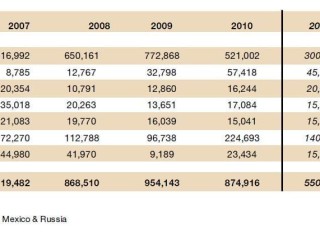 An estimated 200,000 northern cattle previously destined for live export will flow back to domestic markets as a consequence of the live export ban to Indonesia, according to official industry projections released yesterday.
An estimated 200,000 northern cattle previously destined for live export will flow back to domestic markets as a consequence of the live export ban to Indonesia, according to official industry projections released yesterday.
Most of that volume is likely to move towards Queensland over the next 12 to 18 months, Meat and Livestock Australia chief economist Tim McRae predicts.
The Federal Government’s suspension officially lasted for four weeks but the latest market forecasts show that the impact will be felt for much longer.
Delays in bringing Indonesian supply chains up to new Federal Government standards will push the ban to at least eight weeks by the time the first shipment returns to Indonesia next week.
Hundreds of thousands of cattle bred for this year’s export window to Indonesia will have surpassed the 350kg maximum weight limit for the market by the time exports resume in volume.
The restricted nature of the trade under the new arrangements also means that many cash-starved producers will not get cattle onto boats this season and will have to wait until at least March/April next year to generate relieving cash flow.
Meat and Livestock Australia’s mid-year projections released yesterday show that Australia exported 311,379 cattle to live export markets from January to May, worth $262 million to the industry.
Indonesia was the major destination, taking 203,704 cattle, or 65pc of total exports. The balance went to China (19,256 head), Israel (18,784 head) and Russia (12,855 head). Most of the Chinese shipments and 4200 head of the Russian shipments comprised dairy cattle shipped from Victoria.
Additional shipments have also been reported to other destinations such as Egypt since June, but available ABS statistics only record shipments to May.
MLA predicted in February that Australian live cattle exports would total 880,000 head in 2011, but has now revised that downwards by 37.5pc to a total of 550,000 cattle.
Shipments to Indonesia were initially expected to total 500,000 in 2011, but MLA now expects only 300,000 to go to the market this year.
Markets for most of the 200,000 cattle that would normally have gone to Indonesia would now have to be found in Australia.
“They will eventually find their way to slaughter markets over the next 12 to 18 months,” MLA economist Tim McRae told Beef Central yesterday.
“I think they will make their way into western Queensland and move across to Queensland processors eventually."
The timing of that turnoff was heavily dependent on seasonal conditions.
If conditions were good enough northern producers would seek to carry their cattle through to heavier weights, however those who were now overstocked would be looking to destock at any time from now on.
“From reports we’re already starting to see a few being picked up by some big players in the north,” Mr McRae said.
The MLA forecast said that while the agreed supply chain solution for Indonesia had provided some relief to the trade, it would only account for a minority of the cattle that would have previously been shipped to the market.
“While the release of import permits was the final hurdle to re-commencing trade with Indonesia, the actual movement of cattle has taken longer, given the considerable logistics involved in implementing the new system and the disruption to shipping schedules and stock procurement.”
MLA said that of the 250,000 cattle expected to go to live export markets other than Indonesia this year, 76,252 had already shipped between January and May. Most would go to the Middle East/Africa (140,000), China (45,000) and Philippines (20,000).
However MLA said these projections were subject to considerable down and upside risks, because of the uncertainty prevailing in export markets.
Cattle Council of Australia president Greg Brown agrees with MLA’s assessment that many of the diverted cattle out of northern Australia are likely to find their way into Queensland, adding that geography might play a hand in the quality of cattle made available to buyers.
“Cattle off the Barkly region, to the eastern side of the NT are likely to be the first option for cost-effective transfer back into Queensland, for feedlot backgrounding or grass finishing,” he said.
The Barkly’s downs country was the Territory’s best grazing region, meaning the cattle were likely to be showing better weight for age and condition. The Barkly region also tended to have a better standard of genetics than other part of the north, which could make them more attractive to Queensland buyers, Mr Brown said.
For many years, Consolidated Pastoral Company, for example, brought large lines of straight Brahman cattle from its Newcastle Waters property on the Barkly into Queensland for grain-finishing as 100-day Jap Ox in the Teys Miamba feedlot near Condamine.
